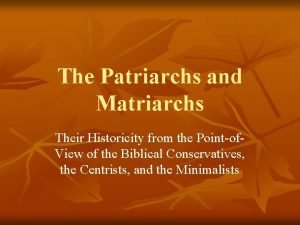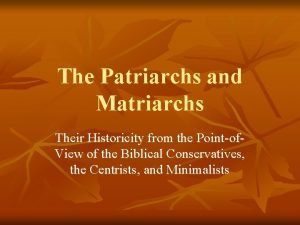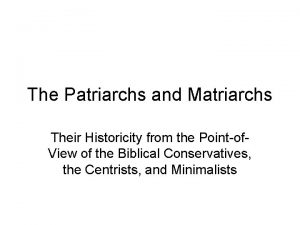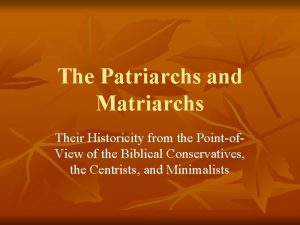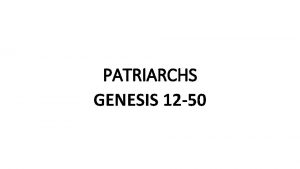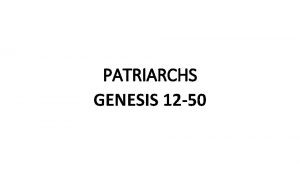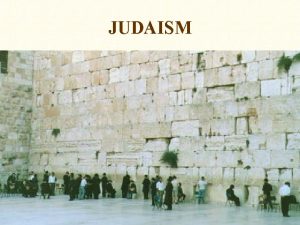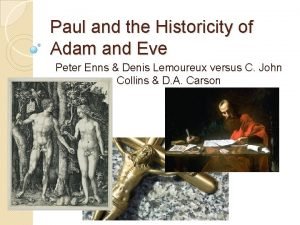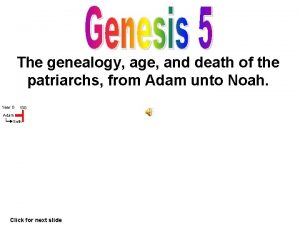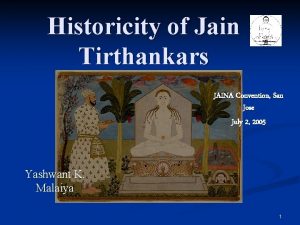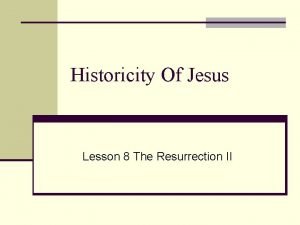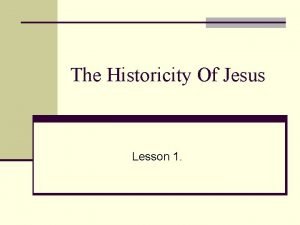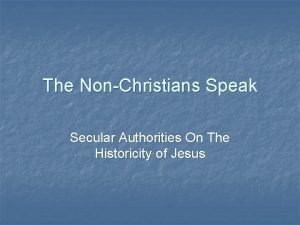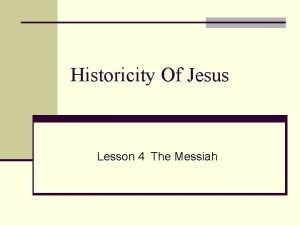The Patriarchs and Matriarchs Their Historicity from the


































- Slides: 34

The Patriarchs and Matriarchs Their Historicity from the Point-of. View of the Biblical Conservatives, the Centrists, and the Minimalists

The Biblical Texts on the Patriarchs and the Matriarchs: Genesis 11. 27 -50. 26: The Story of the Ancestors of Israel; Genesis 11. 27 -25. 18: The Story of Abraham and Sarah; Genesis 11. 27 -32: Introduction to the Abraham story; Genesis 12. 1 -3: The LORD’s call and promise to Abraham; Genesis 12. 4 -9: Abraham’s first journey to the land; Gen 16. 1 -16: Hagar bears Abraham a son; Gen 19. 30 -38: Lot, the father of Moab and the Ammonites; Gen 21. 1 -21: The Birth of Isaac and the Expulsion of Hagar and Ishmael; 2

The Biblical Texts (Contd. ): Gen 24. 1 -67: A Wife for Isaac; Gen 24. 62 -67: The marriage of Isaac and Rebekah; Gen 25. 19 -36. 43: The Story of Isaac and Jacob; Gen 25. 19 -34: The Birth of Esau and Jacob/Israel – twin sons of Isaac and Rebekah; Gen 29. 1 -30: Jacob’s Marriages: Leah and Rachel; and then Zilpah and Bilhah; (The Ancestors of the Twelve Tribes of Israel are the sons of Jacob and four women. ) Gen 37. 1 -50. 26: The Story of Joseph – a Son of Jacob and Rachel 3

Genealogy – Patriarchs and Matriarchs 4

Textbook: “Using Archaeology to Assess the Bible’s Traditions about ‘The Earliest Times’” (pp. 37 -65). The segment on the “Patriarchs”. 5

6 Abraham’s Route – Traditional View.

7

8

9

The Conservatives’ Position Relative to the Stories of the Patriarchs and the Matriarchs: - See the position of R. de Vaux and W. F. Albright on this on pp. 42 -44 of the Textbook; - Many convinced that new discoveries would prove that the Patriarchs were historical figures (Textbook, p. 42); -They found support in that the personal names and landpurchase laws in Genesis are similar to those found in 2 nd millennium B. C. Mesopotamian texts; - a Bedouin way of life practiced by the Patriarchs and Matriarchs and pastoral groups of Mesopotamian origin in Canaan around 2000 B. C. ; - The “Amorite Hypothesis”’ (Albright and the Intermediate Period between the Early and Middle Bronze Age); 10

Bedouin Encampment in the Desert. 11

12

Chronology – Traditional: - Early Bronze IV=Intermediate Bronze Period (22002000 BC); - Middle Bronze II Period (2000 -1550 BC); - Late Bronze Period (1550 -1200 BC); - Iron Age I (1200 -1000 BC); - Iron Age II (1000 -586 BC); - Babylonian and Persian Periods (586 -332 BC); - Hellenistic Period (332 -63 BC). 13

The Conservative Position Relative to the Stories of the Patriarchs and the Matriarchs: - R. de Vaux and the identification of the age of the Patriarchs to the Middle Bronze Age; - Gordon and Speiser: the similarities between social and legal practices in 2 nd m. B. C. Near Eastern texts, e. g. , the Nuzi Tablets (Textbook, p. 44); 14

Cities of Mesopotamia (= modern Iraq) ca. 2000 15

Nuzi Tablets (Late Bronze Age). 16

Genealogy – Patriarchs and Matriarchs 17

Difficulties with the Conservative/Traditional Dating of the Patriarchs and the Matriarchs (Finkelstein): - The nomadic way of life – pastoralists (sheep, goats); - The “Amorite Hypothesis”; - Important sites, e. g. , Shechem, Beer-sheba, and Hebron, mentioned in the stories of Abraham did not yield finds from the Intermediate Bronze Age (Textbook, p. 44); - the problem with using the Nuzi Texts to date the period of the Patriarchs; - “Anachronisms” in the text, e. g. , mention of the Philistines and the Arameans; - Camels in the stories; 18 - the mention of Gerar=Tel Haror in Genesis as a Philistine city.

19

Finkelstein’s Centrist Position: - Stories of the Patriarchs and Matriarchs written from the point-of-view of the kingdoms of Israel and Judah; - The Arameans and the early 9 th century BC; - Stories also reflect the relations that Israel had with its neighbours, namely, Ammon and Moab, in the 8 th and 7 th centuries BC; - Stories of relationships between the brothers Jacob and Esau, the fathers of Israel and Edom, reflect what was happening between Israel and Edom in late-monarchic times (Textbook, p. 47); - the Arabian caravan trade of the 8 th and 7 th centuries BC; - The stories and similarities to the Assyrian and Babylonian empires of the 9 th-6 th centuries BC. 20

The Land of Biblical Israel. 21

Finkelstein’s Position: - The Patriarchal traditions must be considered as a sort of pious “prehistory” of Israel in which Judah played a decisive role (Textbook, p. 50). 22

Martin Noth’s Position: -The Patriarchal stories were separate regional traditions that were assembled into a unified narrative to serve the purpose of politically unifying a heterogeneous Israelite population (Textbook, p. 49); - the geographical focus of the stories provide a clue as to where each of the traditions come from; - the Patriarchs were originally separate regional ancestors which were eventually brought together in a single genealogy in an effort to create a unified history (Textbook, p. 49); 23

The Land of Biblical Israel. 24

Mazar’s Centrist Position: - Parallels between the 2 nd millennium BC culture of the Levant and the cultural background portrayed in the Patriarchal stories are too close to be ignored; - Examples: The MB II period as a time when most of the cities mentioned in the Patriarchal stories, e. g. , Shechem, Bethel, Jerusalem, and Hebron, were settled and fortified; - the personal names in the stories are mostly of the “Amorite” type known from the 2 nd millennium BC; - the stories find parallels in the texts from Mari and Nuzi; - the high position of Joseph in Egypt and the presence of the Hyksos in Egypt; - acknowledgement of the anachronisms in the stories, e. g. camels, Philistines, and Arameans; 25

Chronology – Traditional: - Early Bronze IV=Intermediate Bronze Period (22002000 BC); - Middle Bronze II Period (2000 -1550 BC); - Late Bronze Period (1550 -1200 BC); - Iron Age I (1200 -1000 BC); - Iron Age II (1000 -586 BC); - Babylonian and Persian Periods (586 -332 BC); - Hellenistic Period (332 -63 BC). 26

27

28

Mari – General View of an Excavated Area. 29

Mari – Plan of the City. 30

Mari Tablets. 31

32

Mazar’s Position: -The kernels of these stories are generally considered to be rooted in the MB II period (Textbook, p. 58); (M. Weippert’s position: Patriarchs who lived as Shasu or nomadic people mentioned in the Egyptian texts of the Late Bronze Age. ) - See Textbook, p. 59 for a summary of Mazar’s position; - He acknowledges what happened to the Patriarchal stories in the process of oral transmission and editorial work reflecting much later historical situations; - Patriarchal narratives contain kernels of old traditions and stories rooted in 2 nd millennium BC realia (Textbook, p. 59). 33

The Minimalists’ Position (Textbook, pp. 12 -13): - P. Davies’s position (Textbook, p. 12); - J. Van Seters and T. Thompson (Textbook, p. 58); - Exilic or post-exilic dates for the entirety of the Patriarchal traditions; - No affinity to any 2 nd millennium BC backgrounds; - Today most scholars define the Patriarchal traditions as a late invention with no historical validity (Textbook, p. 50). 34
 Patriarchs and matriarchs
Patriarchs and matriarchs What is the meaning of the patriarchs for our faith today
What is the meaning of the patriarchs for our faith today The prologue romeo and juliet
The prologue romeo and juliet Hình ảnh bộ gõ cơ thể búng tay
Hình ảnh bộ gõ cơ thể búng tay Lp html
Lp html Bổ thể
Bổ thể Tỉ lệ cơ thể trẻ em
Tỉ lệ cơ thể trẻ em Chó sói
Chó sói Tư thế worm breton
Tư thế worm breton Chúa yêu trần thế
Chúa yêu trần thế Môn thể thao bắt đầu bằng chữ đua
Môn thể thao bắt đầu bằng chữ đua Thế nào là hệ số cao nhất
Thế nào là hệ số cao nhất Các châu lục và đại dương trên thế giới
Các châu lục và đại dương trên thế giới Cong thức tính động năng
Cong thức tính động năng Trời xanh đây là của chúng ta thể thơ
Trời xanh đây là của chúng ta thể thơ Mật thư anh em như thể tay chân
Mật thư anh em như thể tay chân Làm thế nào để 102-1=99
Làm thế nào để 102-1=99 Phản ứng thế ankan
Phản ứng thế ankan Các châu lục và đại dương trên thế giới
Các châu lục và đại dương trên thế giới Thể thơ truyền thống
Thể thơ truyền thống Quá trình desamine hóa có thể tạo ra
Quá trình desamine hóa có thể tạo ra Một số thể thơ truyền thống
Một số thể thơ truyền thống Cái miệng xinh xinh thế chỉ nói điều hay thôi
Cái miệng xinh xinh thế chỉ nói điều hay thôi Vẽ hình chiếu vuông góc của vật thể sau
Vẽ hình chiếu vuông góc của vật thể sau Biện pháp chống mỏi cơ
Biện pháp chống mỏi cơ đặc điểm cơ thể của người tối cổ
đặc điểm cơ thể của người tối cổ Thế nào là giọng cùng tên?
Thế nào là giọng cùng tên? Vẽ hình chiếu đứng bằng cạnh của vật thể
Vẽ hình chiếu đứng bằng cạnh của vật thể Tia chieu sa te
Tia chieu sa te Thẻ vin
Thẻ vin đại từ thay thế
đại từ thay thế điện thế nghỉ
điện thế nghỉ Tư thế ngồi viết
Tư thế ngồi viết Diễn thế sinh thái là
Diễn thế sinh thái là Các loại đột biến cấu trúc nhiễm sắc thể
Các loại đột biến cấu trúc nhiễm sắc thể
